Southern Rhône Visit - Easter 2006
|
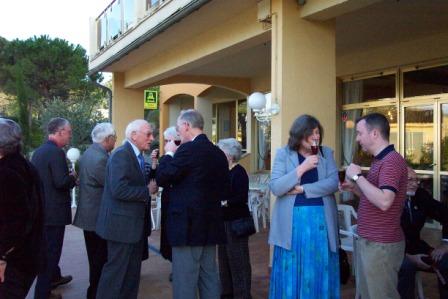 If it is April it must be a DWS foreign trip. If it is 2006 it must be the Southern Rhone, and if it is the Southern Rhone (for this year at any rate) it must be sun, great wine and great food. Twenty-seven members, spouses, and friends travelled by car or by train to our base in Vaison-la-Romaine. A twenty-eighth, Tom Godwin, did a sixteen thousand mile round trip by air from Seattle to remind us that he was still an enthusiastic member. It was warm If it is April it must be a DWS foreign trip. If it is 2006 it must be the Southern Rhone, and if it is the Southern Rhone (for this year at any rate) it must be sun, great wine and great food. Twenty-seven members, spouses, and friends travelled by car or by train to our base in Vaison-la-Romaine. A twenty-eighth, Tom Godwin, did a sixteen thousand mile round trip by air from Seattle to remind us that he was still an enthusiastic member. It was warm 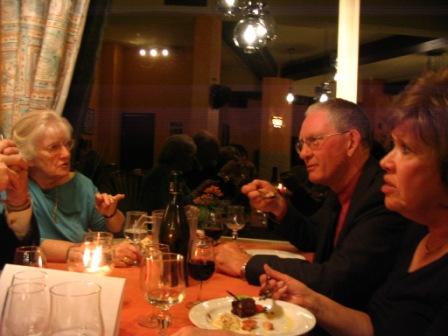 and sunny as people arrived at the Logis-du-Chateau, and they sat on the terrace admiring the view and acquainting themselves with the local rosé. As usual, the official tour started with a welcome reception, not this time with a sparkling wine from the area but with an aperitif invented by Jaques Broc, the Patron called "Myro" a kir-like drink made from Crème de Myrtille and Rosé wine. Dinner was five courses of Provençal food, with wines from Cairanne and Gigondas. and sunny as people arrived at the Logis-du-Chateau, and they sat on the terrace admiring the view and acquainting themselves with the local rosé. As usual, the official tour started with a welcome reception, not this time with a sparkling wine from the area but with an aperitif invented by Jaques Broc, the Patron called "Myro" a kir-like drink made from Crème de Myrtille and Rosé wine. Dinner was five courses of Provençal food, with wines from Cairanne and Gigondas.
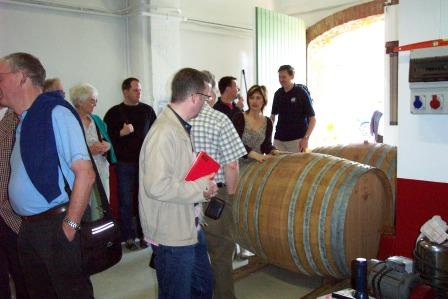 Thursday was another bright day. The coach arrived early and the short journey to Chateau de Trignon in Gigondas opened the serious part of the tour. As well as being one of the leading properties of the appellation, with a string of international awards, its owners, the Roux family, own the Domaine de Sénéchaux in Chateauneuf du Pape. The party split into two parts for the visit to the winery and for an explanation of the domaine’s activities. The tasting from both domaine’s was first class. The 2004 Gigondas was particulatly memorable. The Chateauneufs were excellent as was the Viognier. Thursday was another bright day. The coach arrived early and the short journey to Chateau de Trignon in Gigondas opened the serious part of the tour. As well as being one of the leading properties of the appellation, with a string of international awards, its owners, the Roux family, own the Domaine de Sénéchaux in Chateauneuf du Pape. The party split into two parts for the visit to the winery and for an explanation of the domaine’s activities. The tasting from both domaine’s was first class. The 2004 Gigondas was particulatly memorable. The Chateauneufs were excellent as was the Viognier.
From there it was a short drive to the Domaine des Girasols in Rasteau, 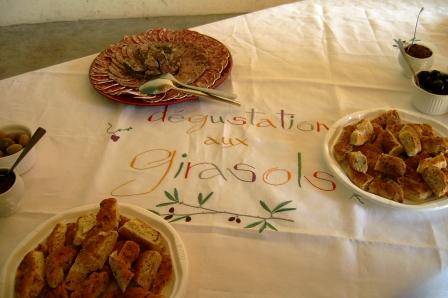 for a vineyard picnic and a tasting. The vineyard was bought around forty years ago by Paul Joyet, a vegetable farmer from near Lyon, whose family farm had been sold. After exploring various regions, fell in live with the situation of the vineyard in Rasteau. He at first sold his grapes to a broker but decided that he wanted to make wine. He studied and set up his own winery, but was not keen on the current style of Rhone wines so he decided to use an adaptation of Beaujolais techniques (semi-carbonic maceration.) for his reds. Paul and his wife Marie-Elizabeth (whose patchwork and embroidery adorn the premises) handed over the business to their daughters – one of whom is the current wine maker. She went to California to learn their methods and came back with a husband who is an integral part of the business. As well as an informative tasting the group enjoyed a splendid vineyard picnic lunch supplied by the Joyets. for a vineyard picnic and a tasting. The vineyard was bought around forty years ago by Paul Joyet, a vegetable farmer from near Lyon, whose family farm had been sold. After exploring various regions, fell in live with the situation of the vineyard in Rasteau. He at first sold his grapes to a broker but decided that he wanted to make wine. He studied and set up his own winery, but was not keen on the current style of Rhone wines so he decided to use an adaptation of Beaujolais techniques (semi-carbonic maceration.) for his reds. Paul and his wife Marie-Elizabeth (whose patchwork and embroidery adorn the premises) handed over the business to their daughters – one of whom is the current wine maker. She went to California to learn their methods and came back with a husband who is an integral part of the business. As well as an informative tasting the group enjoyed a splendid vineyard picnic lunch supplied by the Joyets.
|
There was an hour or two to spare before the next visit so there was break at the beautiful, but hilly, village of Sablet, from where the coach headed to Vacqueyras and the Domaine de Montvac, a domaine that has passed down through the female line for three generations. Cécile Dusserre, blonde, petite and vivacious, 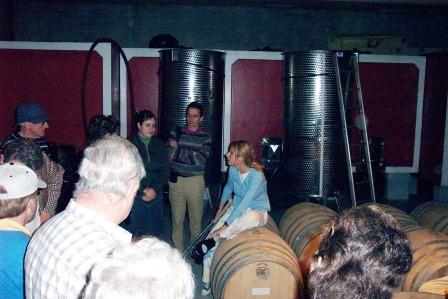 and an excellent winemaker, led the tour and tasting on crutches, having just returned from the hospital having had treatment for an injury at a Dance class. As well as some very good red Vacqueyras she showed an unusual white Vacqueyras, which some thought excellent while others were not enamoured of the new oak. When people started buying wine husband Jean was absent, so Cécile abandoned her crutches and hopped to and fro from the wine store carrying cases of wine! A short drive back to the hotel to a splendid dinner featuring some memorable duck. A certain flamboyant film-maker and restaurant critic might have called it historic. and an excellent winemaker, led the tour and tasting on crutches, having just returned from the hospital having had treatment for an injury at a Dance class. As well as some very good red Vacqueyras she showed an unusual white Vacqueyras, which some thought excellent while others were not enamoured of the new oak. When people started buying wine husband Jean was absent, so Cécile abandoned her crutches and hopped to and fro from the wine store carrying cases of wine! A short drive back to the hotel to a splendid dinner featuring some memorable duck. A certain flamboyant film-maker and restaurant critic might have called it historic.
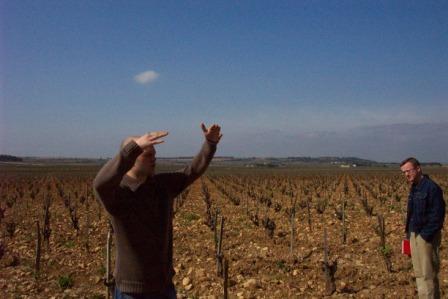 Friday dawned bright and warm for the half hour drive to what was probably highlight of the tour, a visit to Château de Beaucastel, widely considered to be the premier Châteauneuf du Pape property. It is a fine Château on fairly flat ground adjacent to the autoroute at Courthezon. The visit was notable for he presentation by Fabrice Langlois, the sommelier. His was a virtuoso performance – history, oenology, philosophy, music, gastronomy, biodynamics, all delivered with wit and polish had everyone mesmerised. The estate was founded in 1549 when Pierre de Beaucastel bought a barn and a plot of land. Later a manor house was built which still stands today. At the time of Phylloxera in the nineteenth century the vineyard went out of production, only to be revived in 1909 by one Pierre Tramier. Friday dawned bright and warm for the half hour drive to what was probably highlight of the tour, a visit to Château de Beaucastel, widely considered to be the premier Châteauneuf du Pape property. It is a fine Château on fairly flat ground adjacent to the autoroute at Courthezon. The visit was notable for he presentation by Fabrice Langlois, the sommelier. His was a virtuoso performance – history, oenology, philosophy, music, gastronomy, biodynamics, all delivered with wit and polish had everyone mesmerised. The estate was founded in 1549 when Pierre de Beaucastel bought a barn and a plot of land. Later a manor house was built which still stands today. At the time of Phylloxera in the nineteenth century the vineyard went out of production, only to be revived in 1909 by one Pierre Tramier. 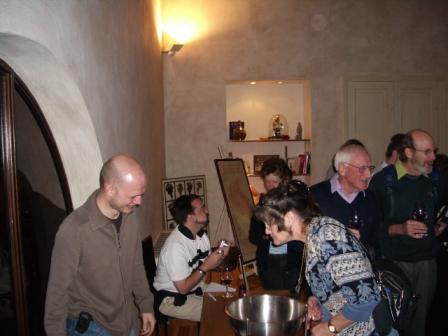 It passed to his son-in-law Pierre Perrin, a scientist who made great progress with the vineyard, which is carried on by his descendants. They farm organically and largely biodynamically, but without saying so on the label. They grow the whole range of permitted Châteauneuf grapes (all thirteen of them) and for the red employ a technique of heating the grapes as they pass into the winery, to increase extraction and lessen the need for sulphur.. As well as the Chateauneufs the tasting included Vacqueyras, Gigondas and Coudelet de Beaucastel. Recently Perrin et fils have been elected to the "Primum Familiae Vini", an organisation of the great family wine houses of the world, including Mouton Rothschild, Antinori, Vega Sicilia, Symington etc. The day of the visit was the Queen’s eightieth birthday, so her health was drunk in Beaucastel. It passed to his son-in-law Pierre Perrin, a scientist who made great progress with the vineyard, which is carried on by his descendants. They farm organically and largely biodynamically, but without saying so on the label. They grow the whole range of permitted Châteauneuf grapes (all thirteen of them) and for the red employ a technique of heating the grapes as they pass into the winery, to increase extraction and lessen the need for sulphur.. As well as the Chateauneufs the tasting included Vacqueyras, Gigondas and Coudelet de Beaucastel. Recently Perrin et fils have been elected to the "Primum Familiae Vini", an organisation of the great family wine houses of the world, including Mouton Rothschild, Antinori, Vega Sicilia, Symington etc. The day of the visit was the Queen’s eightieth birthday, so her health was drunk in Beaucastel.
|
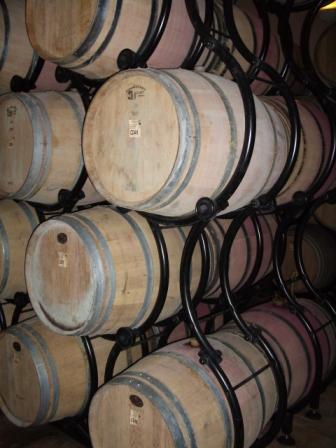 The road to the village of Chataeauneuf-du Pape was under repair and the coach could not get through. Some walked, others went in the coach on a ten mile detour. After a couple of hours for lunch and exploration there was a long drive to Mormoiron for a visit to Château de Pesquié. Pesquié is owned and run by the Chaudière family, in the shadow of the Mont de Ventoux. Founded in the 1980s by Doctors Edith and Paul Chaudière who wanted a change of career, with 70 hectares, 90% of which are in the Côtes de Ventoux appellation, it is a handsome house with a very modern winery. The barrels in the maturing cellar are on wheeled racks so that instead of batonage .the barrels are rotated by hand. A system of pumps means that they do not need to be moved around. The road to the village of Chataeauneuf-du Pape was under repair and the coach could not get through. Some walked, others went in the coach on a ten mile detour. After a couple of hours for lunch and exploration there was a long drive to Mormoiron for a visit to Château de Pesquié. Pesquié is owned and run by the Chaudière family, in the shadow of the Mont de Ventoux. Founded in the 1980s by Doctors Edith and Paul Chaudière who wanted a change of career, with 70 hectares, 90% of which are in the Côtes de Ventoux appellation, it is a handsome house with a very modern winery. The barrels in the maturing cellar are on wheeled racks so that instead of batonage .the barrels are rotated by hand. A system of pumps means that they do not need to be moved around.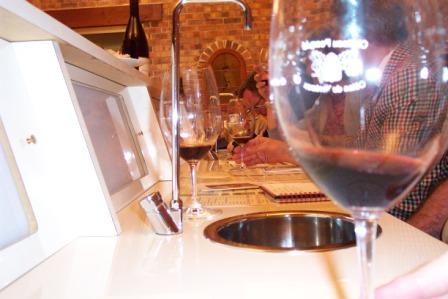 They also have developed malolactic fermentation in barrel. The visit was conducted by the son, Frédéric, with a tasting in the very well fitted professional tasting room, where as well as the "Terrasses" red the Viognier and the premier "Quintessence" white were shown, as was the highly acclaimed "Quintessence" Rouge, but the highlight was a cask sample of their new top cuvee, not then released, a rich, almost flamboyant wine that is sure to command a high price. The return was via the spectacular Col de Madeline. They also have developed malolactic fermentation in barrel. The visit was conducted by the son, Frédéric, with a tasting in the very well fitted professional tasting room, where as well as the "Terrasses" red the Viognier and the premier "Quintessence" white were shown, as was the highly acclaimed "Quintessence" Rouge, but the highlight was a cask sample of their new top cuvee, not then released, a rich, almost flamboyant wine that is sure to command a high price. The return was via the spectacular Col de Madeline.
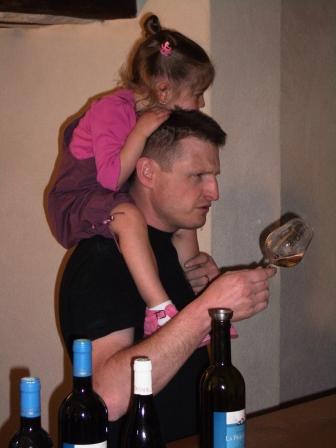 Saturday was yet another golden day, which started with a visit to Domaine de la Pigeade in Beaumes-de-Venise. An old property which used to sell its grapes to the cooperative, it was turned around by the son of the house Thierry Vaute and his wife Marina in 1996. California-trained and at the age of 26 Thierry restored the property and built the winery himself and is now producing very good Côtes du Rhone and Côtes de Ventoux but most of all his excellent Muscat de Beaumes-de-Venise, much more refined than the usual Muscat from the appellation La Pigeade is now regarded as one of the top two or here producers of the appellation. The tasting was enlivened by the presence of two of their delightful small children. It is hoped that Thierry will visit us in Dulwich. Saturday was yet another golden day, which started with a visit to Domaine de la Pigeade in Beaumes-de-Venise. An old property which used to sell its grapes to the cooperative, it was turned around by the son of the house Thierry Vaute and his wife Marina in 1996. California-trained and at the age of 26 Thierry restored the property and built the winery himself and is now producing very good Côtes du Rhone and Côtes de Ventoux but most of all his excellent Muscat de Beaumes-de-Venise, much more refined than the usual Muscat from the appellation La Pigeade is now regarded as one of the top two or here producers of the appellation. The tasting was enlivened by the presence of two of their delightful small children. It is hoped that Thierry will visit us in Dulwich.
|
Saturday afternoon was devoted to sightseeing in Vaison, an important Roman site, which also boasts a fine mediaeval old town. It was just below the Old Town, in what was an old olive mill at the side of the river Ouveze, that the final dinner was held in the Michelin starred "Le Moulin à Huile".
Chef Robert Bardot – one time "Meilleur Ouvrier de France" prepared a splendid meal, which was overseen in the dining room by his wife, with that mixture of charm and steely efficiency which seems to be the preserve of French women. Speeches and farewells over people either walked up the hill to the Logis, or took taxis, ready for a Sunday morning departure.
A good deal of the success of the trip was down to the hotel, and the friendly and efficient service from monsieur and madame Broc and their team – and, of course, the weather.
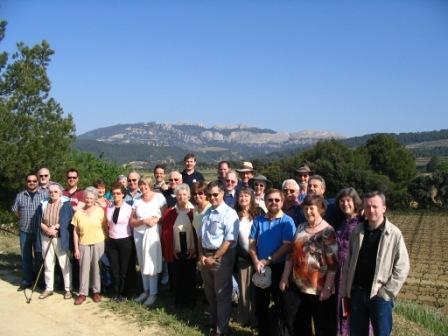 Picture credits: Picture credits:
Ruth Cousins
David How
Bob McClay
Tim Havenhand
|